Bruges is Belgium's most perfectly preserved
medieval town. Bruges is often called the" Venice
of the North".

The city originated on the banks of the river Reie. In the course of time a real town gradually developed, which was connected through canals to the deeper branch of the North Sea, the Zwin.
Church of Our Lady seen here behind the bridge...

There are at least two direct intercity trains per hour and the trip takes 1 hour. Check timetables here: www.belgianrail.be/en

The city originated on the banks of the river Reie. In the course of time a real town gradually developed, which was connected through canals to the deeper branch of the North Sea, the Zwin.
Church of Our Lady seen here behind the bridge...

Its jaw-dropping, beautiful architecture attracts more than two million visitors every year.


Brussels to Bruges train costs the same online as at the station. (We of course had the 10 journey pass as explained in the previous post, so it was very cheap for us)


Brussels to Bruges train costs the same online as at the station. (We of course had the 10 journey pass as explained in the previous post, so it was very cheap for us)
There are at least two direct intercity trains per hour and the trip takes 1 hour. Check timetables here: www.belgianrail.be/en
trains to Brugge (final destination
Oostende or Knokke/ Blankenberge) go through Bruxelles-Nord,
-Central and -Midi.
We walked to the Grand Place on our way to the Central station for our day trip to Bruges
The Town Hall is asymmetrical, since the tower is not exactly in the middle of the building and the left part and the right part are not identical (although they seem at first sight). An old legend known to the people of Brussels tells that the architect who designed the building committed suicide by jumping from the top of the belfry after realizing his "mistake". In fact, the two parts were not built together.
To counter this symbol of municipal power, from 1504 to 1536, the Duke of Brabant ordered a large building to be constructed across from the Town Hall as a symbol of ducal power. It was erected on the site of the first cloth and bread markets, which were no longer in use, and it became known as the King's House although no king has ever lived there. It is currently known as the Maison du Roi (King's House) in French, but in Dutch, it is the Broodhuis (Breadhouse), after the market whose place it took.
Over time, wealthy merchants and the increasingly powerful guilds of Brussels built houses around the square.

We went on to the Central station. Went to the platform after checking the electronic board but the train was delayed. At the last minute there was a platform change. We could not just sit around. Had to stand by the board and watch for changes. The audio announcement was never clear. Pretty stressful but we managed to board the train. Quite a bit of delay from the scheduled time though.
Day 13: 26 April 2019, Wednesday:
BRUSSELS GRAND PLACE:
We walked to the Grand Place on our way to the Central station for our day trip to Bruges
The magnificent Grand-Place "Grand
Square": Grand Place (french)or Grote Markt (dutch), is
the central square of Brussels. The square measures 68 by 110 metres (223 by 361 ft).
It is surrounded by
opulent guildhalls and two larger edifices, city's
Town Hall, and the King's House Breadhouse (French: Maison
du Roi, Dutch: Broodhuis)
building containing the Museum of the City of Brussels.
The Grand Place is the most important
tourist destination and most memorable landmark in
Brussels. considered as one of the most beautiful squares in
Europe,and has been a UNESCO World Heritage Site
Brussels' Town Hall was built on
the south side of the Grand Place in stages, between 1401 and 1455,
and made it the seat of municipal power. Its spire towers 96 m (315 ft) high, and is capped by a 4-m (12 ft) statue
of Saint Michael slaying a demon or devil.
To counter this symbol of municipal power, from 1504 to 1536, the Duke of Brabant ordered a large building to be constructed across from the Town Hall as a symbol of ducal power. It was erected on the site of the first cloth and bread markets, which were no longer in use, and it became known as the King's House although no king has ever lived there. It is currently known as the Maison du Roi (King's House) in French, but in Dutch, it is the Broodhuis (Breadhouse), after the market whose place it took.
Over time, wealthy merchants and the increasingly powerful guilds of Brussels built houses around the square.

Many tragic events unfold during its
history. In 1523, the first Protestant martyrs Henri Voes
and Jean Van Eschen were burned by the Inquisition on
the square. Forty years later, the counts of Egmont and Horn,
who had spoken out against the policies of King Philip II in
the Spanish Netherlands, were beheaded in front of
the Breadhouse.
Guild houses (trade houses, some of
them UNESCO heritage) have been converted into restaurants
and brasseries. Other notable institutions include Godiva
Chocolatier and the Maison Dandoy speculoos confectionery.
We went on to the Central station. Went to the platform after checking the electronic board but the train was delayed. At the last minute there was a platform change. We could not just sit around. Had to stand by the board and watch for changes. The audio announcement was never clear. Pretty stressful but we managed to board the train. Quite a bit of delay from the scheduled time though.
As said above, trains from Brussels to Bruges are all thru Ghent (sometimes stop at AALTER before Gent). Timings are as follows:
We filled our pass with details of our trip and boarded our train
Disembarked at the Bruges station.
Started our walk to the old town with its famous canals.
This is the map I had made:
7 am IC 428 TO OOSTENDE...Midi, Gent and reaches Bruges
7,20 am Bruges
7,28 Courtrai / Kortrijk one change at Ghent
7,49 Blankenberge Knokke
We filled our pass with details of our trip and boarded our train
BRUGES:
Disembarked at the Bruges station.
Started our walk to the old town with its famous canals.
This is the map I had made:
The Bruges' canals are referred to as "Reie", named after the river "Roya" wich used to flow into the Zwin estuary. There is a 2,8 km (1,7 miles) walk, starting at the "Zand Square" and finishing at the Bonifacius bridge near Church of our Lady. This is a very pleasant walk that takes us past the most beautiful, old streets and romantic bridges of the city. Our walk above was 4.8 km. We ended up walking more as we had to walk back to the station too. We had downloaded offline maps on our phone/tablet and pinned the sights as well. So it was easy
Minnewaterpark and the nearby Lake of
Love (Minnewater) is something of an oasis in the city of Bruges.
Bargebrug (bridge), a striking example of asymmetrical architecture, connects the outskirts of the town with Minnewaterpark. This spot is the starting point of a visit to Bruges for many a tourist.
The coastal river Reie entered the city
here. The river was canalized and made to continue to the centre of
town. The lake was used as a water reservoir. Water for the Canals
enter the lake, fed from the Ghent and perimeter canals. The pink
brick lockhouse (Sashuis) which overlooks the long rectangular basin,
regulates the level of the canals in the city center.
A young and pretty girl named Minna
was in love with Stromberg, a warrior of a neighboring tribe. Her
father arranged her to marry a man of his choice. Minna escaped and
ran into the forest. When Stromberg finally found her, she died of
exhaustion in his arms. The lake was named after Minna and the bridge
by the lake was considered the bridge of love, in her honor.
One of the symbols of Bruges is the swan. There are always plenty to be found on the Minnewater. The legend about the swans of Bruges: In 1488 the people of Bruges had executed one of the town administrators belonging to the court of Maximilian of Austria. The town administrator Pieter Lanchals, family coat of arms featured a white swan. Legend has it that Maximilian punished Bruges by obliging the population to keep swans on their lakes and canals till eternity.
The old town is lovely with stunning architecture and medieval fountains
One of the symbols of Bruges is the swan. There are always plenty to be found on the Minnewater. The legend about the swans of Bruges: In 1488 the people of Bruges had executed one of the town administrators belonging to the court of Maximilian of Austria. The town administrator Pieter Lanchals, family coat of arms featured a white swan. Legend has it that Maximilian punished Bruges by obliging the population to keep swans on their lakes and canals till eternity.
The old town is lovely with stunning architecture and medieval fountains

Church of Our lady facade... its tower is 115 m (380 ft) high. tallest structure in the city and second tallest brick tower in the world.
Nice church... Church of Our lady ( Dutch: Onze-Lieve-Vrouwekerk)
Rozenhoedkaai (Quay of the Rosary ) is the most photographed:
Here, the Groenerei and Dijver canals meet, creating a romantic, charming scene.
Rozenhoedkaai was a mooring place for ships back in the late Middle Ages and salt traders came here to unload and load their merchandise. This used to be the salt port. In the Middle Ages salt was as expensive as gold: it served to preserve food and to season dishes.
This is the Burg square... buskers were playing beautiful classical music!


The Basilica of the Holy Blood chapel is located in a corner of the Burg square. This flamboyant facade is actually a 16th century staircase that connects two underlying chapels: the Romanesque Saint-Basilius chapel and the (neo)gothic Holy Blood chapel.

The Basilica of the Holy Blood is a Roman Catholic minor basilica in Bruges. Originally built in the 12th century as the chapel of the residence of the Count of Flanders, the church houses a venerated relic of the Holy Blood allegedly collected by Joseph of Arimathea and brought from the Holy Land by Thierry of Alsace, Count of Flanders. Built between 1134 and 1157, double church, dedicated to Our Lady and Saint Basil.
The Basilica of the Holy Blood consists of a Romanesque lower chapel and a Gothic upper chapel. The two levels could not be more different: the Romanesque lower level is austere with very little decoration, while the Gothic upper level is alive with color and detail.
Upper chapel: The Holy Blood relic is embedded in a rock-crystal vial, which is placed inside a small glass cylinder capped with a golden crown at each end. The relic is kept in a magnificent silver tabernacle with a sculpture of the Lamb of God in the large side chapel of the upper church. More reliquaries can be seen in the Basilica Museum.
The lower chapel, the Chapel of St Basil, is the only Romanesque church in West Flanders.


The two chapels are connected by a monumental brick staircase, which runs behind the grand facade facing the square. The stairs and facade were built in 1533 in the Renaissance style, but demolished during the French occupation. They were rebuilt in the 19th century.
After the Crucifixion, Joseph of Arimathea wiped blood from the body of Christ and preserved the cloth. The relic remained in the Holy Land until the Second Crusade, when the King of Jerusalem Baldwin III gave it to his brother-in-law, Count of Flanders Diederik van de Elzas. The count arrived with it in Bruges on April 7, 1150 and placed it in a chapel he had built on Burg Square.
Recent investigations have showed that the phial, made of rock crystal and dating back to the 11th or 12th century, was a Byzantine perfume bottle made in the area of Constantinople. It was never opened since its arrival in Bruges. Its neck is wound with gold thread and its stopper is sealed with red wax. The phial is encased in a glass-fronted gold cylinder closed at each end by coronets decorated with angels. The date "MCCCLXXXVIII die III maii" (May 3, 1388) is engraved on the frame.
The relic is shown to the public every Friday and also every day from the 3rd to the 17th of May. Outside the chapel is the Holy Blood museum, which contains the shrine for the Holy Blood and other treasures belonging to the chapel.
Shop window displays are GREAT.. lot of glare though, so pics are not clear.
Lace making here

Lovely tea house... innovative kettles and poetry to match...
Yummy treats
Terrific miniatures...
The ubiquitous Mannekin Pis...

In Belgium flag colors...

Walked on enjoying the bridges and canals
Contemporary statue...
We regrouped in our room and then set out for a walk in the old town. When we stepped out of the hotel, it was drizzling steadily. I called it a day. Son went on for the walk in the old town and enjoyed itHere, the Groenerei and Dijver canals meet, creating a romantic, charming scene.
Rozenhoedkaai was a mooring place for ships back in the late Middle Ages and salt traders came here to unload and load their merchandise. This used to be the salt port. In the Middle Ages salt was as expensive as gold: it served to preserve food and to season dishes.
This is the Burg square... buskers were playing beautiful classical music!


The Basilica of the Holy Blood chapel is located in a corner of the Burg square. This flamboyant facade is actually a 16th century staircase that connects two underlying chapels: the Romanesque Saint-Basilius chapel and the (neo)gothic Holy Blood chapel.

Basilica of the Holy Blood:
The Basilica of the Holy Blood is a Roman Catholic minor basilica in Bruges. Originally built in the 12th century as the chapel of the residence of the Count of Flanders, the church houses a venerated relic of the Holy Blood allegedly collected by Joseph of Arimathea and brought from the Holy Land by Thierry of Alsace, Count of Flanders. Built between 1134 and 1157, double church, dedicated to Our Lady and Saint Basil.
The Basilica of the Holy Blood consists of a Romanesque lower chapel and a Gothic upper chapel. The two levels could not be more different: the Romanesque lower level is austere with very little decoration, while the Gothic upper level is alive with color and detail.
Upper chapel: The Holy Blood relic is embedded in a rock-crystal vial, which is placed inside a small glass cylinder capped with a golden crown at each end. The relic is kept in a magnificent silver tabernacle with a sculpture of the Lamb of God in the large side chapel of the upper church. More reliquaries can be seen in the Basilica Museum.
The lower chapel, the Chapel of St Basil, is the only Romanesque church in West Flanders.


The two chapels are connected by a monumental brick staircase, which runs behind the grand facade facing the square. The stairs and facade were built in 1533 in the Renaissance style, but demolished during the French occupation. They were rebuilt in the 19th century.
After the Crucifixion, Joseph of Arimathea wiped blood from the body of Christ and preserved the cloth. The relic remained in the Holy Land until the Second Crusade, when the King of Jerusalem Baldwin III gave it to his brother-in-law, Count of Flanders Diederik van de Elzas. The count arrived with it in Bruges on April 7, 1150 and placed it in a chapel he had built on Burg Square.
However, recent research found no
evidences of the presence of the relic in Bruges before the 1250s. In
all likelihood, the relic originated from the 1204 sack of
Constantinople by the army of the Count of Flanders, Baldwin IX
during the Fourth Crusade.
Recent investigations have showed that the phial, made of rock crystal and dating back to the 11th or 12th century, was a Byzantine perfume bottle made in the area of Constantinople. It was never opened since its arrival in Bruges. Its neck is wound with gold thread and its stopper is sealed with red wax. The phial is encased in a glass-fronted gold cylinder closed at each end by coronets decorated with angels. The date "MCCCLXXXVIII die III maii" (May 3, 1388) is engraved on the frame.
The relic is shown to the public every Friday and also every day from the 3rd to the 17th of May. Outside the chapel is the Holy Blood museum, which contains the shrine for the Holy Blood and other treasures belonging to the chapel.
Lace making here

Lovely tea house... innovative kettles and poetry to match...
Yummy treats
Terrific miniatures...
The ubiquitous Mannekin Pis...

In Belgium flag colors...

Walked on enjoying the bridges and canals
Contemporary statue...
We had had a great flavor of the city. We started walking back to the station
FOR going back from Bruges to Brussels, train options are as follows:
FOR going back from Bruges to Brussels, train options are as follows:
16.31 PLATFORM 5: IC Brussels Airport-Zaventem:17.01 at GHENT; stations after Ghent (Gand-Saint-Pierre / Gent-Sint-Pieters ), MIDI OR ZUID, then CENTRAAL... Final airport
16.57 Platform 9 IC Train IC 516 to Eupen;17.23 at GHENT;
17.08 PLATFORM 5: IC 1516 to Genk 17.37 at GHENT; … repeated for the next hour.
We got on our train, filled our pass with details and reached Brussels. Here's a contemporary statue at Place d'Espagne on Agora place [This is the progressive Mayor Charles Buls (1837-1914) who served as the Mayor for 18 years in the 19th century and took on King Leopold to preserve some of the city from redevelopment! The good Mayor also advocated dual language (Dutch and French) and education for women]
BACK IN BRUSSELS:
We got on our train, filled our pass with details and reached Brussels. Here's a contemporary statue at Place d'Espagne on Agora place [This is the progressive Mayor Charles Buls (1837-1914) who served as the Mayor for 18 years in the 19th century and took on King Leopold to preserve some of the city from redevelopment! The good Mayor also advocated dual language (Dutch and French) and education for women]
Mannekin Pis... the little boy who is famous for being famous!
He's ubiquitous... in front of bakeries, as a treat and even on top of the yummy waffles...
Went up to Mont des Arts and Place Royale and turned back
This had been the original plan for our walk
part 1 from Mannekin pis to
Cathédrale des Sts-Michel-et-Gudule
Then the plan was to take BUS 5 Herrmann-Debroux from
PARC, 4 stops, 7 min, MERODE, 450 m to AUTOWORLD.
Parc de la
Cinquentenaire was also on the agenda. We hope to do these missing stuff on our next visit!
Report on our trip to Ghent is here:








































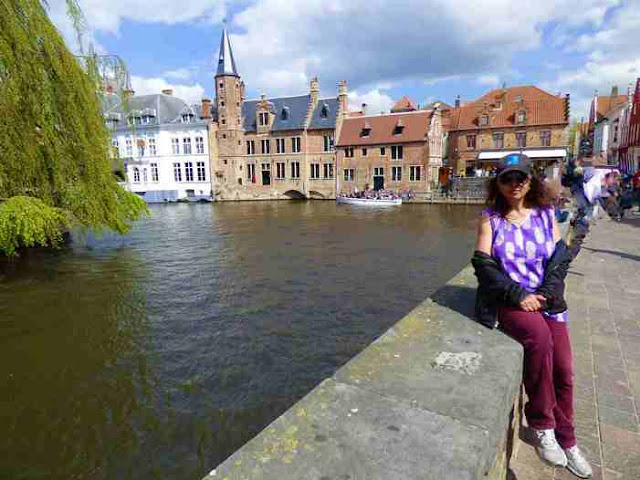




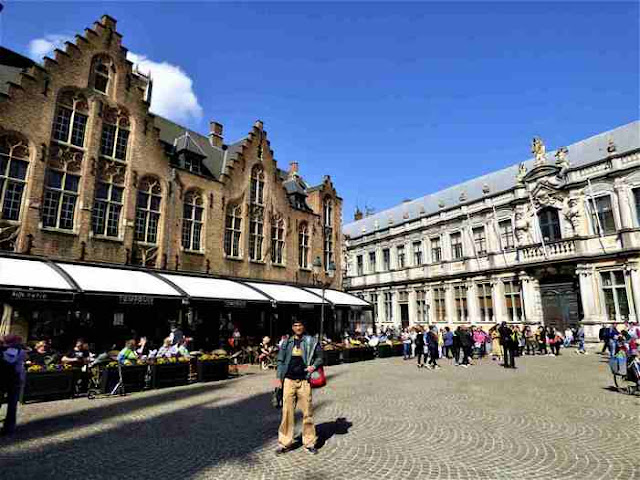

























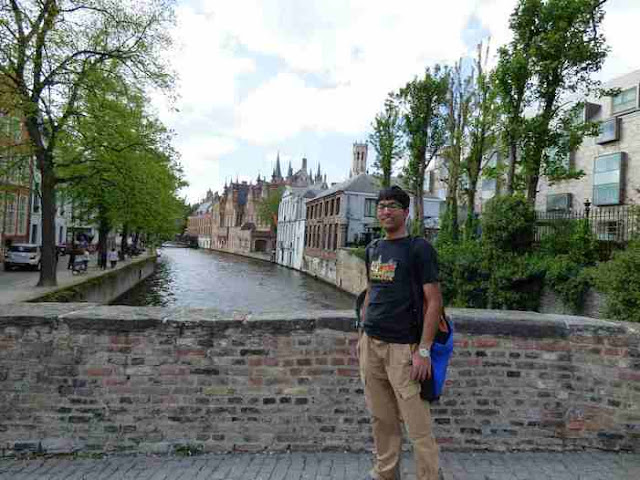



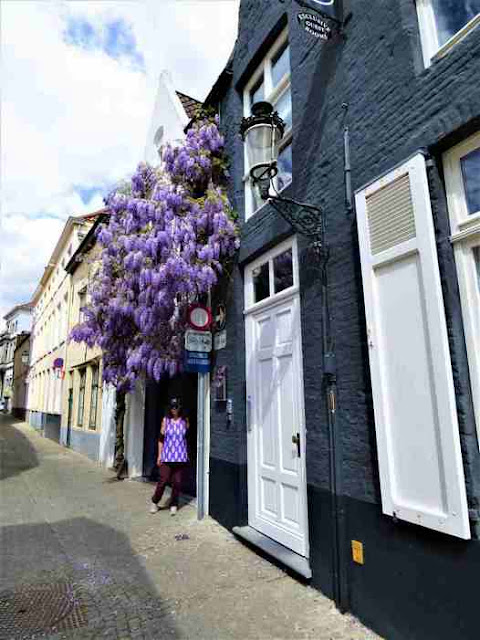





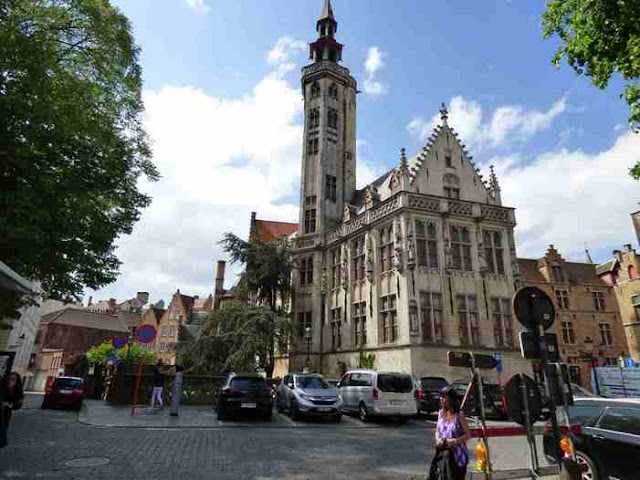











































No comments:
Post a Comment